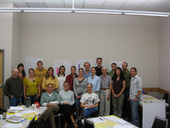Highlight
Preparing IGERT Trainees for Leadership in the Classroom
Achievement/Results
Trainees in the IGERT program “Montana Ecology of Infectious Diseases” are being prepared for leadership, not just in the laboratory or in the field, but also in the classroom. Most graduate students receive little or no training to help them understand how people learn and how to teach effectively, and consequently have limited resources to draw upon when they enter the classroom. M-EID trainees and other interested graduate students and faculty at the University of Montana will be much better prepared, thanks to a series of workshops on scientific teaching conducted by Diane Ebert-May, Professor of Plant Biology at Michigan State University and a leader in this emerging area.
The scientific teaching approach encourages faculty to teach science in a way that represents the nature of science and is grounded in the science of teaching—in other words, based on evidence about how people learn. Key practices in scientific teaching involve the teacher setting learning goals that represent the nature of science, choosing learning activities that engage a diversity of students in thinking and acting like scientists, and making use of assessment methods that help measure progress toward the learning goals and provide useful feedback to both teachers and students. One focus is on active learning, during which students learn science by questioning, investigating, analyzing, and discovering. Rather than being treated as passive recipients for course content, students are involved in learning exercises—thinking, questioning, discussing, writing, experimenting, etc.—that actively engage them in constructing new knowledge. Dr. Ebert-May modeled a number of active learning methods during the workshops, and described how they can be used even in large gateway courses.
Two M-EID trainees who participated in the workshops, Tammi Johnson and Erin Landguth, were inspired to develop an undergraduate-level course “Spatial Epidemiology Applications in GIS” they will offer during the fall 2008 semester. The course is designed to teach GIS techniques to students interested in public health, epidemiology, and infectious disease, and of course, to apply the principles of scientific teaching.
Address Goals
Cultivating a world-class science and engineering workforce and expanding the scientific literacy of all citizens requires, in part, individuals who are both highly competant scientists and able to teach effectively. Providing trainees with instruction in scientific teaching will help prepare them to be outstanding instructors who will inspire and educate the next generation of students, thereby attracting students to careers in science and promoting scientific literacy in all the students they teach.






